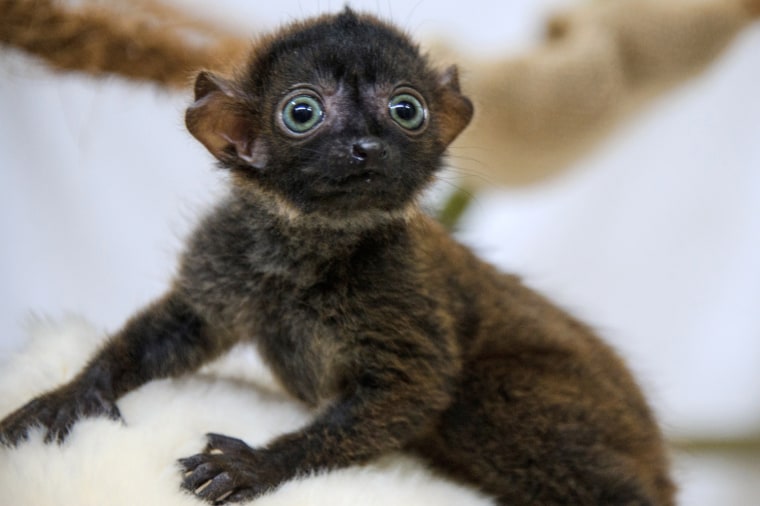Infants respond to the voices of their doting parents — but it's not just human voices that hold them spellbound. In what may be a hallmark of our ancestry, human brains begin life hard-wired to hear the calls of non-human primates, an ability that fades away after just a few months.
Past studies with infants have shown that deep cognitive wheels are set turning as they listen to human speech. Now researchers have found that sounds from the blue-eyed Madagascar lemur engage their attention, too, in ways that artificial sounds don't.
"The link is sufficiently broad to include the call of this adorable lemur," Sandra Waxman, professor of cognitive psychology at Northwestern University and a co-author on the new study, told NBC News. "The fact that there's this precocious link between language and thought ... it's just hands-down amazing."
In the first months of childhood, "twin engines of development" — nature and nurture — are at work, Waxman explained. Babies are born sensitive to primate sounds, even from non-humans. When they grow older, they no longer pay attention to the non-human sounds. It's the human voices that stay relevant in their lives.
'Candy to a baby's ears'
Waxman and colleagues studied how 72 infants between the ages of 3 months and 6 months responded to human, lemur and artificial sounds. The babies listened to high-pitched baby talk — "It's like candy to a baby's ears," Waxman said — and similarly high-pitched lemur calls. They also heard human speech played backward, and mechanical tones.
The difference was clear. "They were doing some much fancier cognitive dancing during the lemur and human vocalization than in the case of backward speech or tones," Waxman explained.
Babies can't answer questions verbally, and it will be years before they can fill out multiple-choice surveys. So for psychologists, the gaze of babies — where they look, and for how long — is a tried-and-true way of indicating whether they're engaged.

In the tests conducted by Waxman and her colleagues, 3- and 4-month-olds were shown a series of eight similar shapes — all dinosaurs — projected on a screen in front of them. In the background, one of the four kinds of sounds would play on a loop. Then they were shown an image of a ninth dinosaur, placed next to a dissimilar image shaped like a fish.
"If the baby has noticed what's common about the objects, they're going to prefer this as one over the other," Waxman explained.
The babies who were trained on the first eight images while they listened to the speech played backward or the mechanical tones didn't master the categorization task as easily as they did when they heard the human or lemur sounds. That indicates that the babies were less engaged in the task while they were listening to the artificial sounds.
The babies who were 6 months old exhibited a different trend: They seemed receptive to the human voices, but not to the lemur calls. That suggests that they lost their sensitivity to the non-human primate sounds because they were hearing human voices all the time.
Having established that babies can be sensitive to the lemur sounds, Waxman and her colleagues are working on refining their understanding of the qualities of lemur calls and human voices that attract an infant's attention, and finding out what other kinds of sounds — primate or otherwise — can bring out a similar response.
Meanwhile, a second study at Waxman's lab is investigating whether babies can retain their ability to engage with lemur calls and human voices, if their parents play them the lemur calls at bedtime every day.
More about language in humans and friends:
- Baby apes and humans teach lessons about language
- Dolphins call each other by name
- Humans wired for grammar at birth
Alissa Ferry, Susan Hespos and Sandra Waxman are authors of "Nonhuman Primate Vocalizations Support Categorization in Very Young Human Infants," published in the Proceedings of the National Academy of Sciences.
Nidhi Subbaraman writes about technology and science. You can follow her on Facebook, Twitter and Google+.
